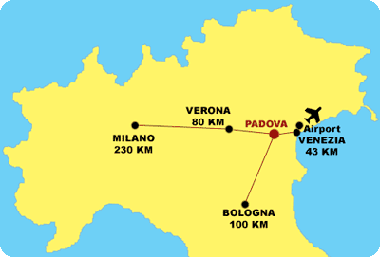Travel and tourism
Prato della Valle
Piazza dei Signori
Basilica San'Antonio
Piazza del'erbe
Getting here

Flights to any of the above require a shuttle (click here), a bus, or a train (click here). Venice is the most convenient by far. There is another airport in Treviso as well which would require a shuttle or two trains. There are also night trains from various locations around Europe as well which may be appealing to those hoping to minimize your carbon footprint and want to save time.
Hotel Options
B&B hotel Padova (10 minutes from conference by foot): Book via email bb_6004@hotelbb.com mentioning "PTNCE23".
SINGLE €75.00/night
DOUBLE €90.00/night
Our rates are per room, per night, VAT, WiFi, Smart TV with Sky channels, parking included + BREAKFAST INCLUDED.
The garage costs € 10.00 per night.
City tax (2,00 EUR per person, per night) is not included.
Before arrival (Credit card/bank transfer)
No penality until 7 days before arrival.
Hotel Igea (15 minutes from conference by foot): Book via email info@hoteligea.it mentioning "PTNCE23".
SINGLE €75.00/night
DOUBLE €90.00/night (1 person)
DOUBLE €105.00/night (2 people)
BREAKFAST INCLUDED
The garage costs € 12.00 per night.
City tax (2,00 EUR per person, per night) is not included.
Tourism Options
15 best things to do via Tripadvisor
10 best restaurants via Tripadvisor
My Food Recommendations
Pizza: La Lanterna, Vecchia, Pago Pago
Coffee/Cafe: The Coffeebox, Caffe V, Caffeine, Eroica, DiVi
Outdoor drinking: 100%, Pier88, Giardini dell'Arean Romana, Enoteca Severino
Indoor drinking: La Moscheta, Cantina Del Gufo, Old England Pub
Padua (/ˈpædjuə/ PAD-ew-ə; Italian: Padova [ˈpaːdova] (![]() listen); Venetian: Pàdova) is a city and comune in Veneto, northern Italy. Padua is on the river Bacchiglione, west of Venice. It is the capital of the province of Padua. It is also the economic and communications hub of the area. Padua's population is 214,000 (as of 2011). The city is sometimes included, with Venice (Italian Venezia) and Treviso, in the Padua-Treviso-Venice Metropolitan Area (PATREVE) which has a population of around 2,600,000.
listen); Venetian: Pàdova) is a city and comune in Veneto, northern Italy. Padua is on the river Bacchiglione, west of Venice. It is the capital of the province of Padua. It is also the economic and communications hub of the area. Padua's population is 214,000 (as of 2011). The city is sometimes included, with Venice (Italian Venezia) and Treviso, in the Padua-Treviso-Venice Metropolitan Area (PATREVE) which has a population of around 2,600,000.
Padua stands on the Bacchiglione River, 40 kilometres (25 miles) west of Venice and 29 km (18 miles) southeast of Vicenza. The Brenta River, which once ran through the city, still touches the northern districts. Its agricultural setting is the Venetian Plain (Pianura Veneta). To the city's south west lies the Euganaean Hills, praised by Lucan and Martial, Petrarch, Ugo Foscolo, and Shelley.
Padua appears twice in the UNESCO World Heritage List: for its Botanical Garden, the most ancient of the world, and the 14th-century Frescoes, situated in different buildings of the city centre.[3] (An example is the Scrovegni Chapel painted by Giotto at the beginning of 1300.)
The city is picturesque, with a dense network of arcaded streets opening into large communal piazze, and many bridges crossing the various branches of the Bacchiglione, which once surrounded the ancient walls like a moat.
Saint Anthony, the patron saint of the city, was a Portuguese Franciscan who spent part of his life in the city and died there in 1231.
The city hosts the famous University of Padua, which was founded in 1222 when a group of students and professors decided to leave the University of Bologna to have more freedom of expression.[4] At the University of Padua, Galileo Galilei was a lecturer between 1592 and 1610.
Padua is the setting for most of the action in Shakespeare's The Taming of the Shrew. There is a play by the Irish writer Oscar Wilde entitled The Duchess of Padua.
It is also known as "the city of the three withouts" by its inhabitants as it homes the Cafe without doors (Pedrocchi Café, as it never closed in the past), the meadow without grass (Prato della Valle, in ancient time a bog, now one of the biggest squares in Europe) and the Saint without a name (referred to St. Anthony's Church, called by the Paduani simply "the Saint")
History of UniPD
The University of Padua was established in 1222, after a group of students and teachers decided to come here from Bologna. They set up a free body of scholars, who were grouped according to their place of origin into nationes, in which students approved statutes, elected the rettore (rector, or chancellor) and chose their teachers, who were paid with money the students collected. Defending freedom of thought in study and teaching became a distinctive feature which today lives on in the University motto: Universa Universis Patavina Libertas.
The introduction of empirical and experimental methods together with the teaching of theory marked the dawn of a golden age. In the 16th and 17th centuries, Padua became a workshop of ideas and the home to figures who changed the cultural and scientific history of humanity. They included Andrea Vesalio, who founded modern anatomy, as well as the astronomer Copernicus, and Galileo, who observed the skies here.
Padua also vaunts the world’s first university botanical garden and a permanent anatomical theatre, which was built by Girolamo Fabrici d’Acquapendente. William Harvey, who became famous for describing the circulation of the blood, studied in Padua, and in 1678 Elena Lucrezia Cornaro Piscopia became the first woman in the world to be awarded a university degree.
The fall of the Serenissima Republic of Venice in 1797 marked the beginning of a dark age. Padua fell under the rule of first the French and then the Austrians, passing through Italy’s tumultuous Risorgimento, which also affected the University.
Between the late 19th and early 20th centuries, the University expanded to include the faculties of Engineering, Pharmacy, and Political Sciences together with its traditional faculties of Law, Medicine, Arts and Philosophy, and Sciences.
The advent of Fascism curtailed the University’s values of free thought and cultural independence. Its professors swore allegiance to the regime, after which the approval of Italy’s racial laws and the expulsion of Jewish professors opened one of the darkest periods in the University’s history. Rector Concetto Marchesi shook the University from its slumber and, at the height of the German occupation made a courageous appeal to the students to fight for the freedom of Italy. For its sacrifices in the name of Liberation, the University of Padua was awarded a gold medal for military valour, the only university to receive such an honour.
During the post-war period, the University opened faculties of Education, Agricultural Sciences, and Psychology and, in the 1990s, faculties of Veterinary Medicine, and Economics and Business Administration. In the 20th century, the University of Padua produced great literary figures such as Diego Valeri and Concetto Marchesi; engineers of the stature of Giuseppe Colombo, the “master of celestial mechanics”; mathematicians such as Tullio Levi Civita; jurists Alfredo Rocco and Livio Paladin; philosophers Luigi Stefanini and Enrico Opocher; and doctors like Vincenzo Gallucci, who carried out the first heart transplant in Italy. The new millennium opened with some important new discoveries, particularly in medicine, biomedicine, engineering and aerospace technology.
At the origins of modern Medicine (pdf file) - a lecture by Giorgio Zanchin





